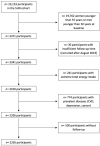Mediterranean Alcohol-Drinking Patterns and All-Cause Mortality in Women More Than 55 Years Old and Men More Than 50 Years Old in the "Seguimiento Universidad de Navarra" (SUN) Cohort
- PMID: 36558468
- PMCID: PMC9788476
- DOI: 10.3390/nu14245310
Mediterranean Alcohol-Drinking Patterns and All-Cause Mortality in Women More Than 55 Years Old and Men More Than 50 Years Old in the "Seguimiento Universidad de Navarra" (SUN) Cohort
Abstract
Background: Most of the available epidemiological evidence on alcohol and chronic disease agrees on recommending alcohol abstention to young people, but some controversy exists about the most appropriate recommendation for alcohol abstention for people of older ages. A growing body of evidence suggests that the pattern of alcohol consumption is likely to be a strong effect modifier. The Mediterranean Alcohol Drinking Pattern (MADP) represents a score integrating several dimensions of drinking patterns (moderation, preference for red wine, drinking with meals, and avoiding binge drinking). Our aim was to clarify this issue and provide more precise recommendations on alcohol consumption.
Methods: We prospectively followed-up 2226 participants (men older than 50 years and women older than 55 years at baseline) in the Seguimiento Universidad de Navarra (SUN) cohort. We classified participants into three categories of adherence to the MADP score (low, moderate, and high), and we added a fourth category for abstainers. Cox regression models estimated multivariable-adjusted hazard ratios (HR) of all-cause death and 95% confidence intervals (CI) using low MADP adherence as the reference category.
Results: The strongest reduction in risk of mortality was observed for those with high adherence to the MADP, with an HR of 0.54 (95% CI: 0.37-0.80). The moderate adherence group (HR = 0.65, 95% CI: 0.44-0.96) and the abstention group (HR = 0.60, 95% CI: 0.36-0.98) also exhibited lower risks of mortality than the low MADP adherence group.
Conclusions: based on the available evidence, a public health message can be provided to people older than 50 years as follows: among those who drink alcohol, high adherence to the MADP score could substantially reduce their risk of all-cause mortality.
Keywords: MADP; Mediterranean diet; alcohol; binge drinking; drinking pattern; elderly; moderate drinking; mortality.
Conflict of interest statement
The authors declare no conflict of interest.
Figures
Similar articles
-
Mediterranean alcohol-drinking pattern and mortality in the SUN (Seguimiento Universidad de Navarra) Project: a prospective cohort study.Br J Nutr. 2014 May 28;111(10):1871-80. doi: 10.1017/S0007114513004376. Epub 2014 Jan 30. Br J Nutr. 2014. PMID: 24480368
-
Mediterranean diet, alcohol-drinking pattern and their combined effect on all-cause mortality: the Seguimiento Universidad de Navarra (SUN) cohort.Eur J Nutr. 2021 Apr;60(3):1489-1498. doi: 10.1007/s00394-020-02342-w. Epub 2020 Jul 31. Eur J Nutr. 2021. PMID: 32737614
-
Mediterranean Alcohol-Drinking Pattern and Arterial Hypertension in the "Seguimiento Universidad de Navarra" (SUN) Prospective Cohort Study.Nutrients. 2023 Jan 7;15(2):307. doi: 10.3390/nu15020307. Nutrients. 2023. PMID: 36678178 Free PMC article.
-
Should we remove wine from the Mediterranean diet?: a narrative review.Am J Clin Nutr. 2024 Feb;119(2):262-270. doi: 10.1016/j.ajcnut.2023.12.020. Epub 2023 Dec 28. Am J Clin Nutr. 2024. PMID: 38157987 Review.
-
Alcohol, Drinking Pattern, and Chronic Disease.Nutrients. 2022 May 7;14(9):1954. doi: 10.3390/nu14091954. Nutrients. 2022. PMID: 35565924 Free PMC article. Review.
Cited by
-
Physical Health-Related Quality of Life in Relation to Mediterranean Diet Adherence in a Sample of Greek Asthma Patients: A Pilot Study.J Pers Med. 2023 Oct 20;13(10):1512. doi: 10.3390/jpm13101512. J Pers Med. 2023. PMID: 37888123 Free PMC article.
-
High Adherence to a Mediterranean Alcohol-Drinking Pattern and Mediterranean Diet Can Mitigate the Harmful Effect of Alcohol on Mortality Risk.Nutrients. 2023 Dec 24;16(1):59. doi: 10.3390/nu16010059. Nutrients. 2023. PMID: 38201889 Free PMC article.
References
-
- WHO . Global Status Report on Alcohol and Health 2018. World Health Organization; Geneva, Switzerland: 2018.
-
- WHO Regional Office for Europe . Status Report on Alcohol Consumption, Harm and Policy Responses in 30 European Countries 2019. WHO Regional Office for Europe; Copenhagen, Denmark: 2019.
MeSH terms
Substances
LinkOut - more resources
Full Text Sources
Medical


